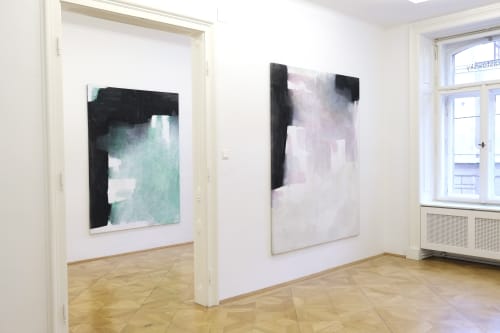Walter Vopava - the Sir of black painting
(Florian Steininger)
Since the mid-1990s, Walter Vopava has been working with powerful, heavy black forms that define the pictorial situation. The processual brushstroke in strokes disappears in favour of a harmoniously pulsating colour field painting. On the one hand, the massive, floating forms burst the boundaries of the picture, while on the other, they stand in a well-composed relationship to one another on the picture surface. The abstract forms overlap or are staggered and layered in rhythmic tension to one another. While the contours of the painted forms were still cloudy and open in the 1990s, a certain rigour has emerged in recent years - angular transitions between light and dark, form and ground. Bar structures float in space, sometimes drifting off, visible only at the outermost edges of the picture. A clear brightening occurs here, the dark gives way to the light. The light constant is sometimes increased to such an extent that a glistening white pushes into the foreground. Atmosphere is particularly evident in the smoky shades of purple, sulphur yellow and green that characterise his current paintings.
The colour black is a constant in Vopava's pictorial inventions: It suggests heaviness, monumentality, massiveness and emphasises Vopava's reduced, even ascetic use of means. In addition to the intention of anchoring black as an independent colour in the picture, Vopava also works with the non-colour black as a dark value, as a basis ‘to allow something to emerge from the dark’. In this way, nuanced brightness values emerge from the dark painting ground. The artist does not intend black to have any substantive meaning.
Vopava's approach to painting is decidedly purist. Using elementary means, he explores the substance of painting, sweeping aside any pretence. For him, abstraction is not necessarily a style, but the possibility of concentrating on the essential in painting, detached from the pretence of content and figuration.


